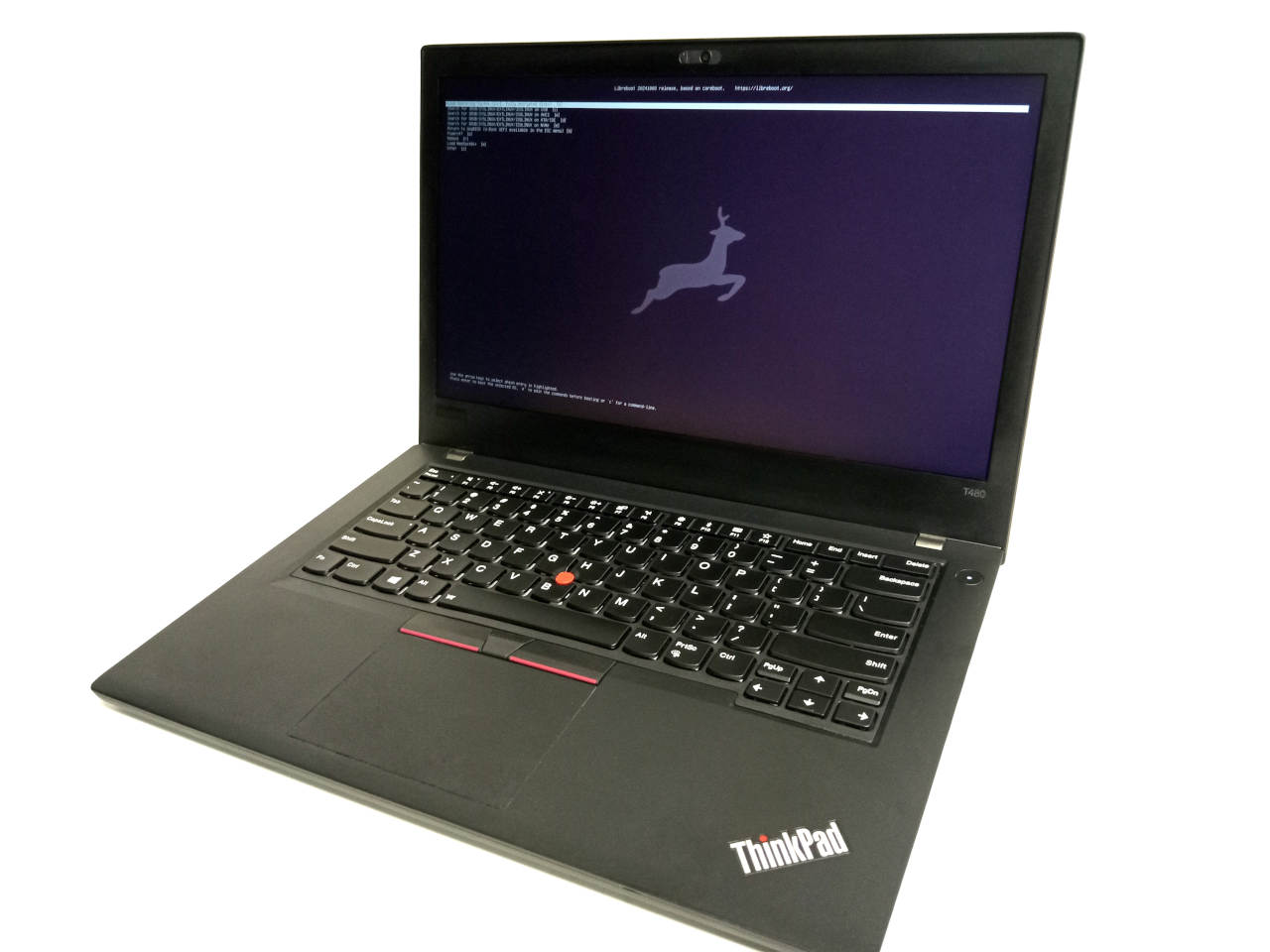



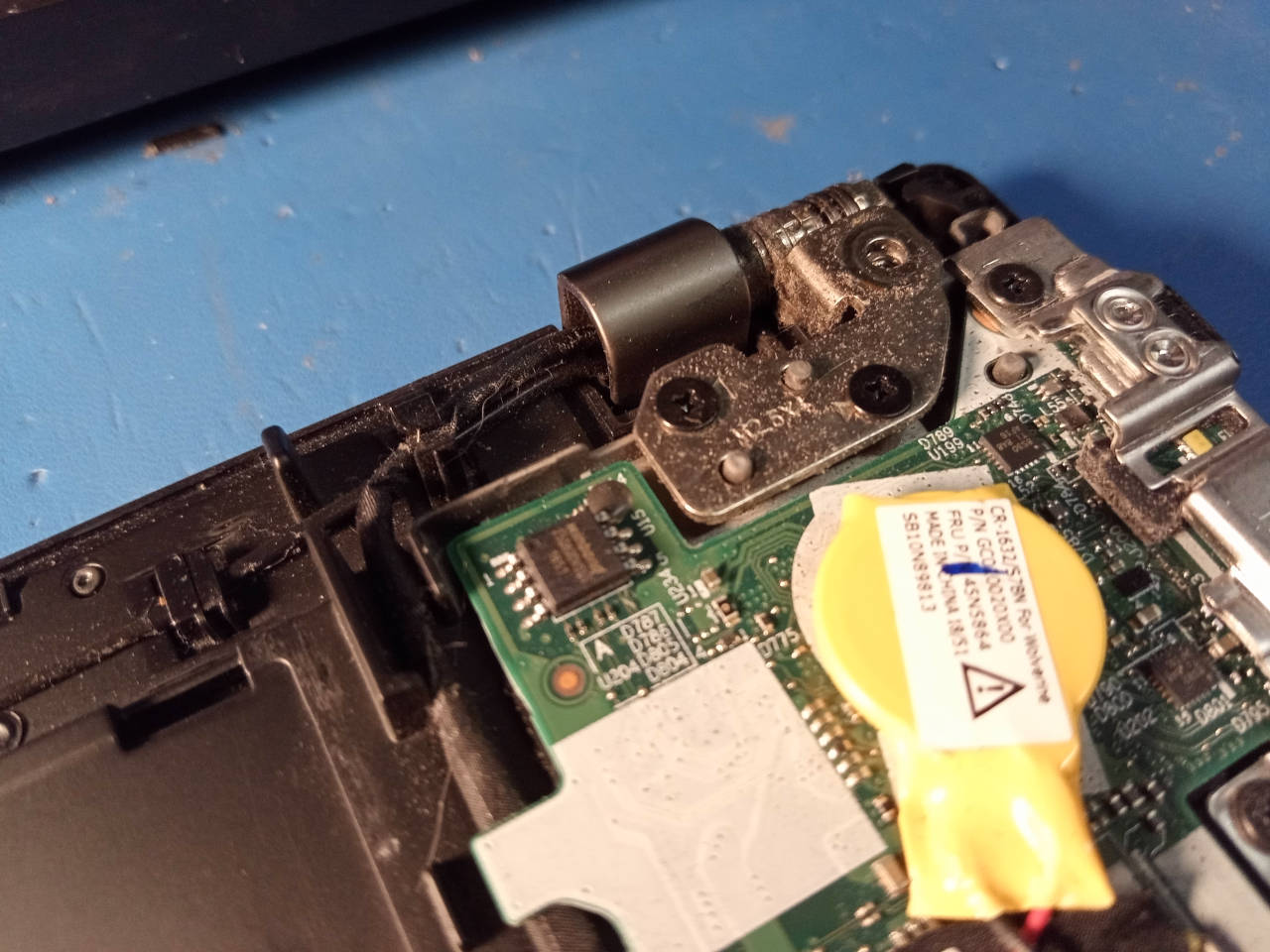
 It's also present on the T480S (S model), but in a different location; on
the S model, the main system flash is still located somewhere near the
centre of the board, and the ThunderBolt flash near the edge of the board, as
it is on the T480, but the T480/T480s use slightly different wiring and they
have a slightly different board layout.
If that flash gets full, thunderbolt PCI-E stops working and fast charging
stops working, but slow charging still works. The issue can be prevented by
updating the firmware. See:
It's also present on the T480S (S model), but in a different location; on
the S model, the main system flash is still located somewhere near the
centre of the board, and the ThunderBolt flash near the edge of the board, as
it is on the T480, but the T480/T480s use slightly different wiring and they
have a slightly different board layout.
If that flash gets full, thunderbolt PCI-E stops working and fast charging
stops working, but slow charging still works. The issue can be prevented by
updating the firmware. See:
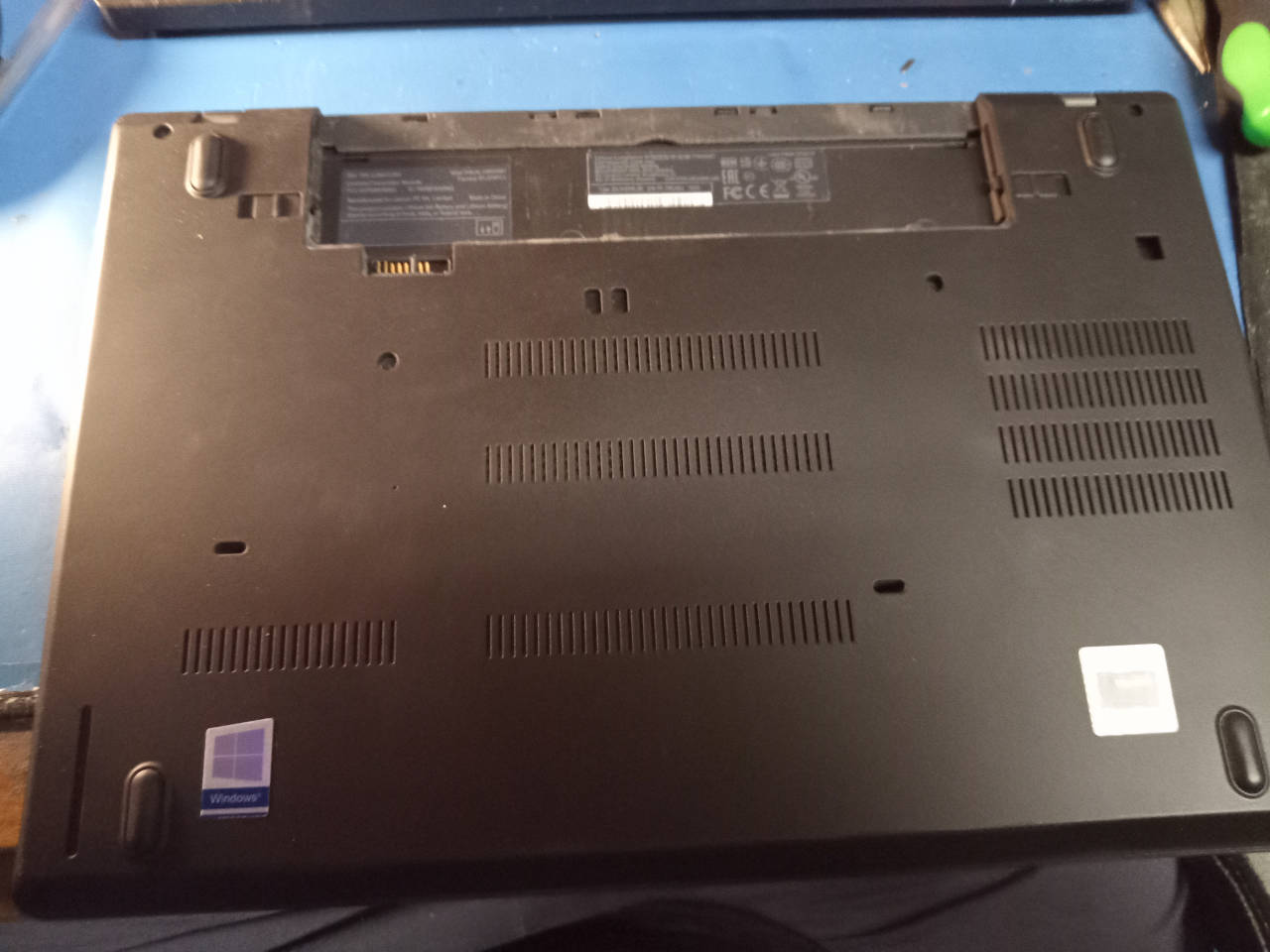
 Remove all screws, and you can gently pry off the lower chassis and remove,
which then allows you to see the inner mainboard:
Remove all screws, and you can gently pry off the lower chassis and remove,
which then allows you to see the inner mainboard:
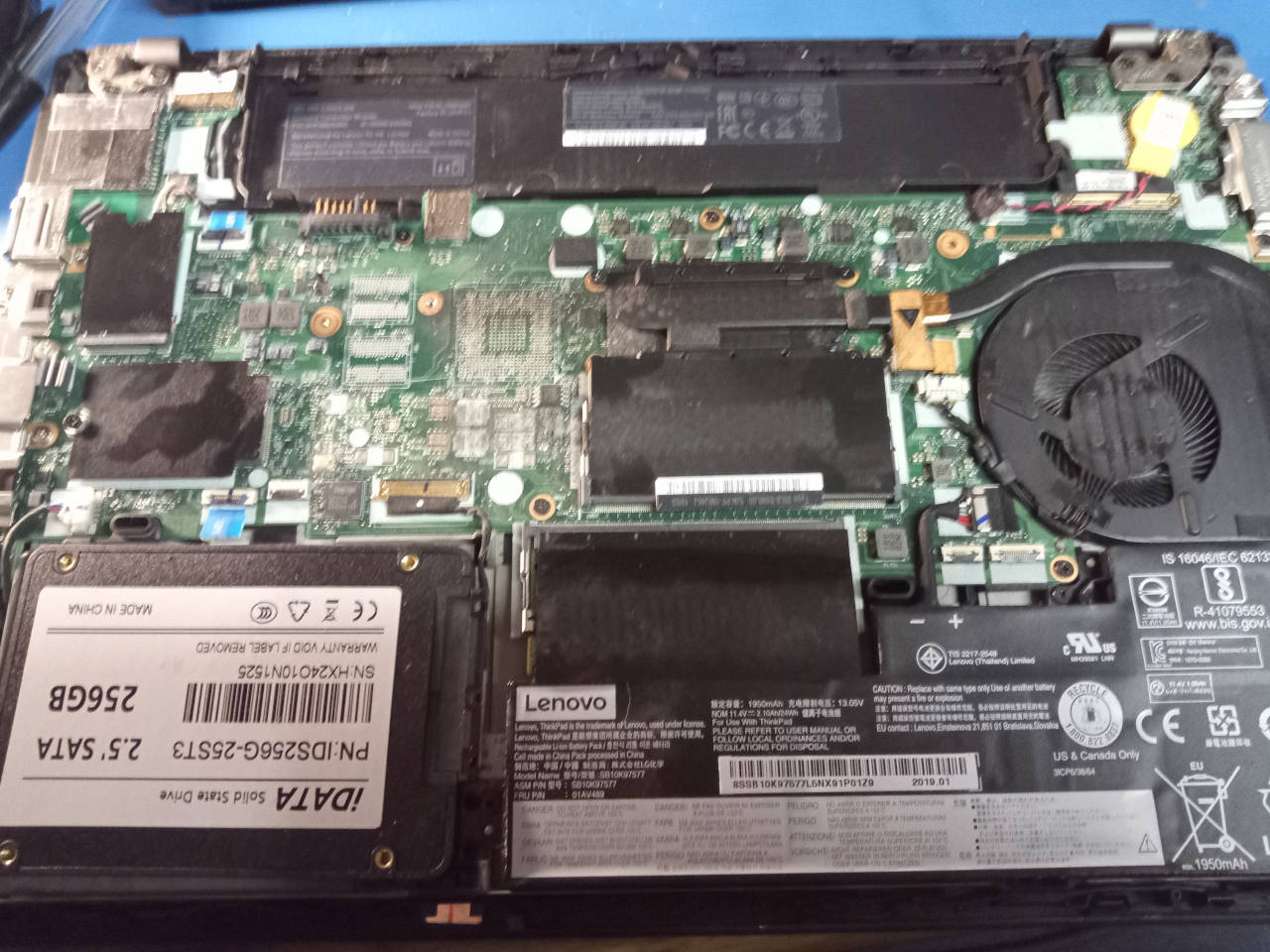
 **WARNING: PLEASE MAKE SURE to remove the battery before flashing. The T480
and T480s can both contain INTERNAL batteries, and the T480 has an additional
external battery. Remove the internal battery via the connector, like so (T480):**
**WARNING: PLEASE MAKE SURE to remove the battery before flashing. The T480
and T480s can both contain INTERNAL batteries, and the T480 has an additional
external battery. Remove the internal battery via the connector, like so (T480):**
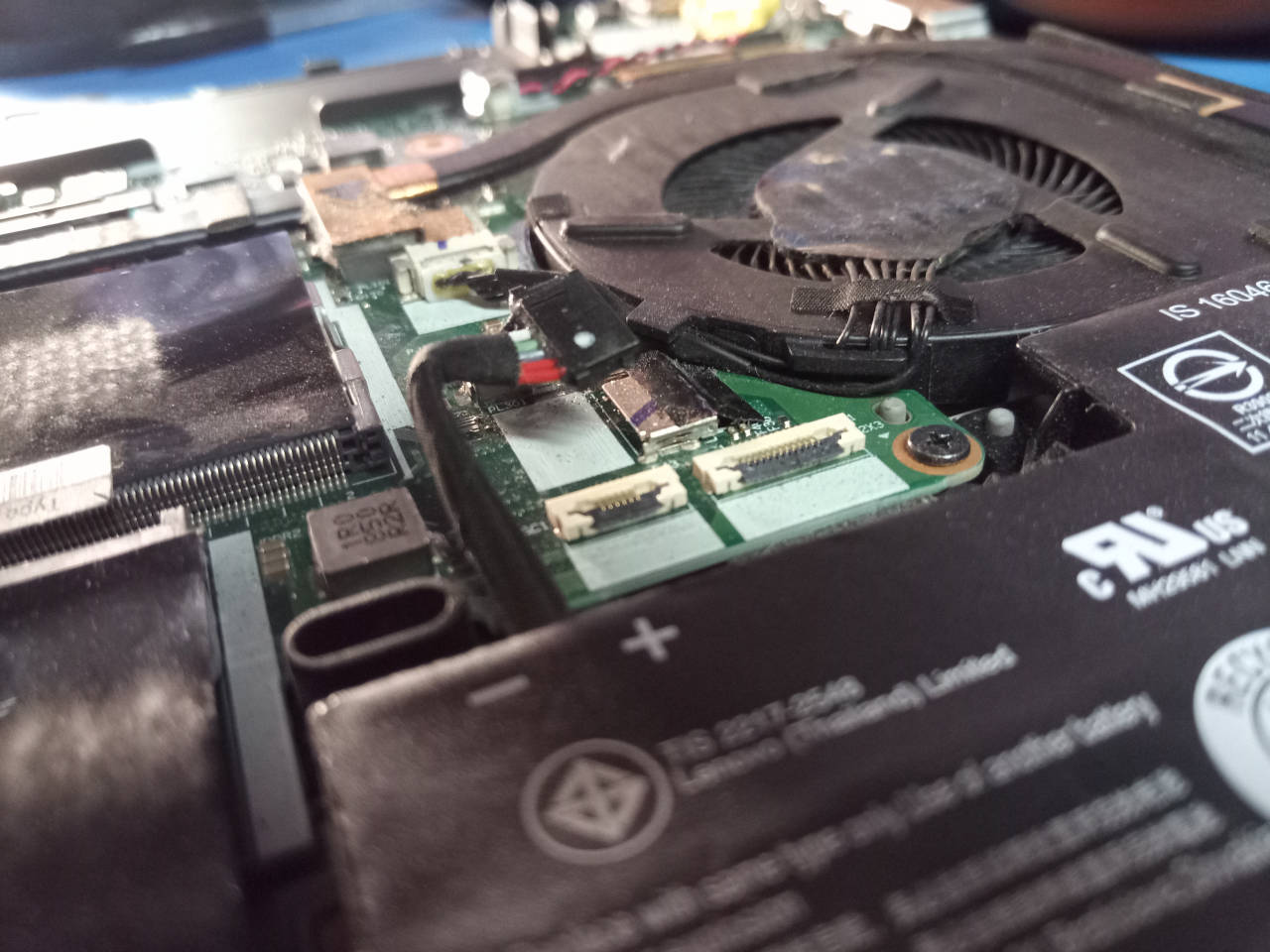
 On the T480s (S model) the internal battery is much larger, and the connector
on it is built into the battery, so it is necessary to carefully remove the
entire battery; on regular T480 (non-S model) the internal battery can be
isolated via the connector as depicted above.
This photo shows the flash:
On the T480s (S model) the internal battery is much larger, and the connector
on it is built into the battery, so it is necessary to carefully remove the
entire battery; on regular T480 (non-S model) the internal battery can be
isolated via the connector as depicted above.
This photo shows the flash:
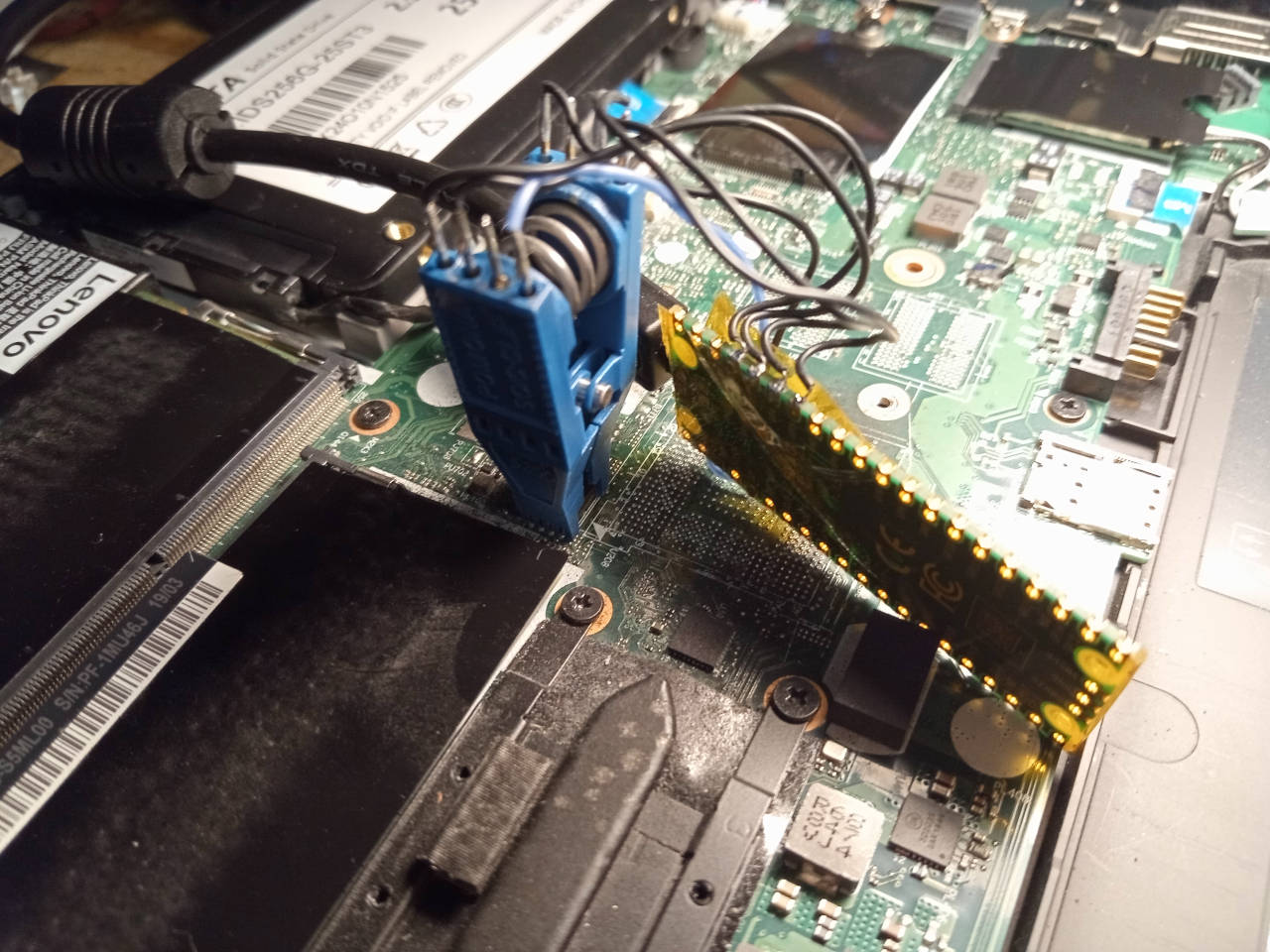
 There is another flash, for the Thunderbolt firmware, which you are to briefly
ignore; we'll cover it later:
There is another flash, for the Thunderbolt firmware, which you are to briefly
ignore; we'll cover it later:

 To be clear: the system flash (16MB) is what you put Libreboot on. The
Thunderbolt firmware flash is much smaller, so you'll know because flashprog
will complain about wrong flash size if you're trying to flash the wrong one.
On the T480s (S model), the flashes are in slightly different places but in
both machines, the system flash (for Libreboot) is toward the centre, near
the memory.
Post-installation
=================
These next sections will tell you how to use certain hardware features, which
work a little bit differently due to idiosyncrasies of coreboot.
How to use the headphone jack
--------------
Sometimes the headphone jack might not work automatically. Simply install
the `pavucontrol` program. Under Output Devices, you can select the headphones
you've inserted manually.
If it says "Unplugged", try it anyway. The HDA Verb may be incorrect. This
will be investigated and a hotfix patch made to the Libreboot 20241206 images.
How to use HDMI audio
------------------
You can get audio from Displayport/HDMI, but you must select it manually.
For example, you can select it in `pavucontrol` if you're using PulseAudio or
PipeWire.
Touchscreen on T480
-------------------
The touchscreen was tested, and confirmed working. Not all models have it,
but it does indeed work perfectly on ones that do.
How to use backlight controls
-----------------------------
Backlight controls work, via software control (e.g. `xbacklight` utility), but
the Fn keys for it don't currently work, as of 6 December 2024.
You can set the backlight manually, or use a hotkey, depending on your window
manager or desktop environment.
UART (T480 only. Not T480S)
----
**NOT supported on the S model (T480s). Please only do it on a T480.**
The EC on ThinkPad T480 has a UART available, and it is enabled in coreboot,
as used by Libreboot. However, you must use a *specific* EC firmware version.
Please read notes elsewhere in this page regarding Lenovo UEFI/EC BIOS updates;
an exact version number is referenced, which you must install prior to Libreboot
installation.
Ways to flash the EC firmware from Libreboot have not yet been established. Now,
please observe the following photo:
To be clear: the system flash (16MB) is what you put Libreboot on. The
Thunderbolt firmware flash is much smaller, so you'll know because flashprog
will complain about wrong flash size if you're trying to flash the wrong one.
On the T480s (S model), the flashes are in slightly different places but in
both machines, the system flash (for Libreboot) is toward the centre, near
the memory.
Post-installation
=================
These next sections will tell you how to use certain hardware features, which
work a little bit differently due to idiosyncrasies of coreboot.
How to use the headphone jack
--------------
Sometimes the headphone jack might not work automatically. Simply install
the `pavucontrol` program. Under Output Devices, you can select the headphones
you've inserted manually.
If it says "Unplugged", try it anyway. The HDA Verb may be incorrect. This
will be investigated and a hotfix patch made to the Libreboot 20241206 images.
How to use HDMI audio
------------------
You can get audio from Displayport/HDMI, but you must select it manually.
For example, you can select it in `pavucontrol` if you're using PulseAudio or
PipeWire.
Touchscreen on T480
-------------------
The touchscreen was tested, and confirmed working. Not all models have it,
but it does indeed work perfectly on ones that do.
How to use backlight controls
-----------------------------
Backlight controls work, via software control (e.g. `xbacklight` utility), but
the Fn keys for it don't currently work, as of 6 December 2024.
You can set the backlight manually, or use a hotkey, depending on your window
manager or desktop environment.
UART (T480 only. Not T480S)
----
**NOT supported on the S model (T480s). Please only do it on a T480.**
The EC on ThinkPad T480 has a UART available, and it is enabled in coreboot,
as used by Libreboot. However, you must use a *specific* EC firmware version.
Please read notes elsewhere in this page regarding Lenovo UEFI/EC BIOS updates;
an exact version number is referenced, which you must install prior to Libreboot
installation.
Ways to flash the EC firmware from Libreboot have not yet been established. Now,
please observe the following photo:
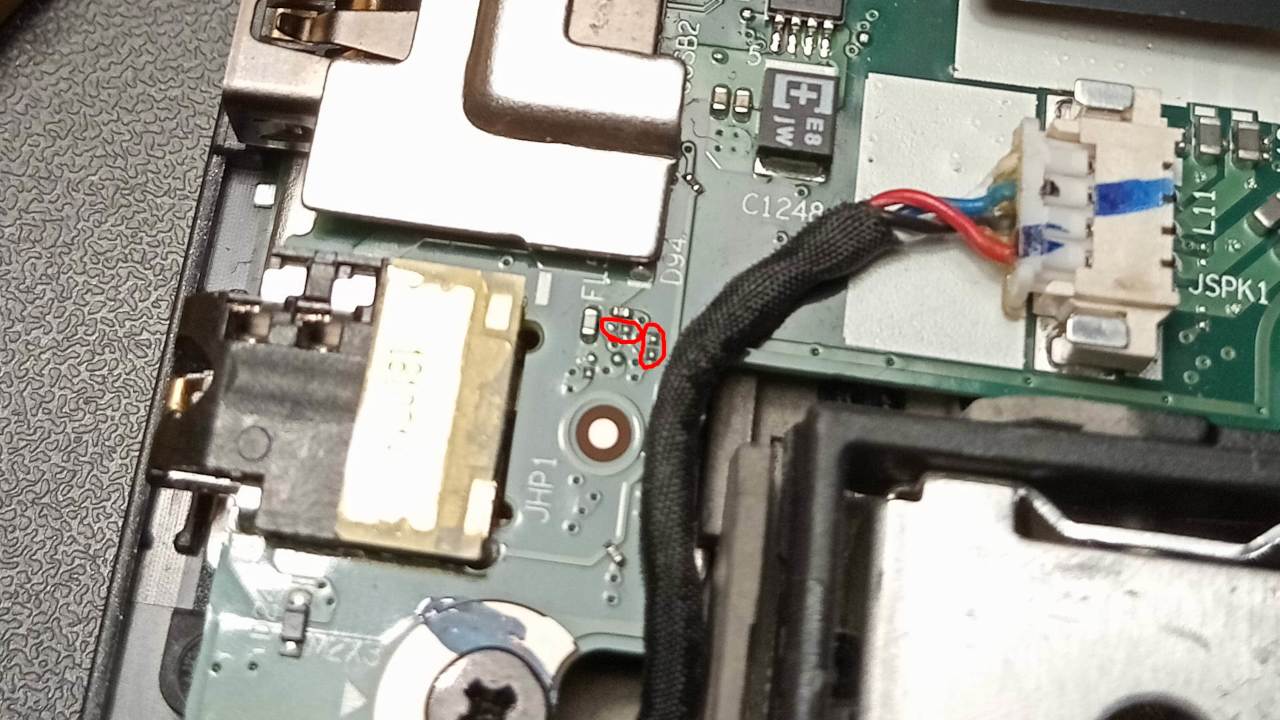
 You will solder zero-ohm jumpers on the indicated footprints. These correspond
to TX and RX, which are connected to the R and L lines on the headphone jack,
respectively; a ground will also be available.
You must solder the zero-ohm jumpers, for UART to work. They are *0201* type
jumpers, which are extremely small. Please only do this if you have *excellent*
soldering skills because it's easy to goof this up if you're not careful.
You can hook this up to any 3.3v TTL UART dongle, to get a serial console.
Idea for 2nd NVMe mod
----------------------
Interestingly, on boards without the Nvidia graphics, the solder pads for all
the componentry (including the GPU) is still present, so you could theoretically
design a QSB that solders to the right pads, and use it to wire a 2nd NVMe SSD;
the port is still enabled in Libreboot even if nothing is plugged into it, so it
should just work. (this doesn't actually exist yet, but it is electrically
possible, quite feasible to design/manufacture and already supported in the
Libreboot firmware in principle, since than PCI-E lane is enabled in the devicetree)
Mate Kukri came up with this idea. It's a great idea, so it's written here.
This mod is possible on both the T480 and T480s, though on T480s there would
be less clearance; using a smaller internal battery and having a makeshift
NVMe caddy in the remaining space would be how to go about it there. On the
regular T480, the existing caddy area could easily fit two NVMe drives.
Errata
======
Some features either don't work, or are untested, when running Libreboot on
the ThinkPad T480 or T480s.
TPM disabled
------------
The TPM is disabled on this device, to prevent hanging/boot delay in SeaBIOS,
due to buggy TPM drivers there.
Legacy 8254 timer
-----------------
Legacy 8254 timer enabled in coreboot, to prevent SeaBIOS from hanging.
HyperThreading on T480/T480s
----------------------
Also called SMT. This is a feature where you get 2 threads on a single core.
It can improve performance in some workloads, but is actually a performance
liability in others, depending on your OS kernel/scheduler and the actual
workload.
It is a security liability, due to the Spectre/Meltdown attacks, so we
recommend turning it off, at the very least from your running operating system.
On *this* platform, you can easily turn it off from coreboot.
**Libreboot disables HyperThreading by default**, from Libreboot 20241206 rev8
onward, on this board. To turn it back on, please [build from source](../build/)
and before running the build command, do this:
./mk -m coreboot t480_vfsp_16mb # replace t480 with t480s if needed
In the menu that appears, go *Chipset -> Enable Hyperthreading* and turn it on.
Then exit from the menu, saving the config where prompted. You will see this
menu twice, because there are *two* configs for each of these boards.
SMT is rarely of benefit in practise, but can be useful in some circumstances.
For example, if you're compiling a large codebase from source that takes hours,
SMT increases the building speed by about 15 percent; for example, a 3 hour
build job might take about 2 hours and 40 minutes instead.
NFC support in T480
-------------------
Some T480 models might have NFC support but this is untested in Libreboot, and
probably dosen't work in current Libreboot releases.
The PCH's NFC device is unsupported in Linux anyway.
Smartcard reader
----------------
The smartcard reader is enabled but it is still untested. If you have one,
please test it and report back to the Libreboot project.
Thunderbolt not supported yet
-----------------------------
Thunderbolt is a way to get PCI-E on a USB port. With it, you can use
high-bandwidth devices such as 10Gbps network interfaces.
The thunderbolt controller is currently unconfigured, so you can't use
Thunderbolt, but the thunderbolt and regular USB-C connector can both be
used for charging, and both can be used for video output (it shows up in xrandr
as a DisplayPort).
[This patch](t480-thunderbolt-20241206-unstable.patch) can be added, enabling
Thunderbolt, but be warned: it is completely untested, as of Libreboot 20241206.
This patch is *NOT* included in the release, because it breaks on S3 resume,
and may cause a kernel panic. Also: currently testing only reveals that the
ThunderBolt controller shows up.
You also need the [gerrit patch](https://review.coreboot.org/c/coreboot/+/75286)
adding a Thunderbolt driver to coreboot.
To apply these patches, do the following in a fresh clone of `lbmk.git` and do:
```
git checkout 20241206-t480-thunderbolt-unstable
```
In it, you'll find this commit:
```
commit 3881160b863ff53df9064a29a25aab55c76ee9c4 (HEAD -> 20241206-t480-thunderbolt-unstable)
Author: Leah Rowe
You will solder zero-ohm jumpers on the indicated footprints. These correspond
to TX and RX, which are connected to the R and L lines on the headphone jack,
respectively; a ground will also be available.
You must solder the zero-ohm jumpers, for UART to work. They are *0201* type
jumpers, which are extremely small. Please only do this if you have *excellent*
soldering skills because it's easy to goof this up if you're not careful.
You can hook this up to any 3.3v TTL UART dongle, to get a serial console.
Idea for 2nd NVMe mod
----------------------
Interestingly, on boards without the Nvidia graphics, the solder pads for all
the componentry (including the GPU) is still present, so you could theoretically
design a QSB that solders to the right pads, and use it to wire a 2nd NVMe SSD;
the port is still enabled in Libreboot even if nothing is plugged into it, so it
should just work. (this doesn't actually exist yet, but it is electrically
possible, quite feasible to design/manufacture and already supported in the
Libreboot firmware in principle, since than PCI-E lane is enabled in the devicetree)
Mate Kukri came up with this idea. It's a great idea, so it's written here.
This mod is possible on both the T480 and T480s, though on T480s there would
be less clearance; using a smaller internal battery and having a makeshift
NVMe caddy in the remaining space would be how to go about it there. On the
regular T480, the existing caddy area could easily fit two NVMe drives.
Errata
======
Some features either don't work, or are untested, when running Libreboot on
the ThinkPad T480 or T480s.
TPM disabled
------------
The TPM is disabled on this device, to prevent hanging/boot delay in SeaBIOS,
due to buggy TPM drivers there.
Legacy 8254 timer
-----------------
Legacy 8254 timer enabled in coreboot, to prevent SeaBIOS from hanging.
HyperThreading on T480/T480s
----------------------
Also called SMT. This is a feature where you get 2 threads on a single core.
It can improve performance in some workloads, but is actually a performance
liability in others, depending on your OS kernel/scheduler and the actual
workload.
It is a security liability, due to the Spectre/Meltdown attacks, so we
recommend turning it off, at the very least from your running operating system.
On *this* platform, you can easily turn it off from coreboot.
**Libreboot disables HyperThreading by default**, from Libreboot 20241206 rev8
onward, on this board. To turn it back on, please [build from source](../build/)
and before running the build command, do this:
./mk -m coreboot t480_vfsp_16mb # replace t480 with t480s if needed
In the menu that appears, go *Chipset -> Enable Hyperthreading* and turn it on.
Then exit from the menu, saving the config where prompted. You will see this
menu twice, because there are *two* configs for each of these boards.
SMT is rarely of benefit in practise, but can be useful in some circumstances.
For example, if you're compiling a large codebase from source that takes hours,
SMT increases the building speed by about 15 percent; for example, a 3 hour
build job might take about 2 hours and 40 minutes instead.
NFC support in T480
-------------------
Some T480 models might have NFC support but this is untested in Libreboot, and
probably dosen't work in current Libreboot releases.
The PCH's NFC device is unsupported in Linux anyway.
Smartcard reader
----------------
The smartcard reader is enabled but it is still untested. If you have one,
please test it and report back to the Libreboot project.
Thunderbolt not supported yet
-----------------------------
Thunderbolt is a way to get PCI-E on a USB port. With it, you can use
high-bandwidth devices such as 10Gbps network interfaces.
The thunderbolt controller is currently unconfigured, so you can't use
Thunderbolt, but the thunderbolt and regular USB-C connector can both be
used for charging, and both can be used for video output (it shows up in xrandr
as a DisplayPort).
[This patch](t480-thunderbolt-20241206-unstable.patch) can be added, enabling
Thunderbolt, but be warned: it is completely untested, as of Libreboot 20241206.
This patch is *NOT* included in the release, because it breaks on S3 resume,
and may cause a kernel panic. Also: currently testing only reveals that the
ThunderBolt controller shows up.
You also need the [gerrit patch](https://review.coreboot.org/c/coreboot/+/75286)
adding a Thunderbolt driver to coreboot.
To apply these patches, do the following in a fresh clone of `lbmk.git` and do:
```
git checkout 20241206-t480-thunderbolt-unstable
```
In it, you'll find this commit:
```
commit 3881160b863ff53df9064a29a25aab55c76ee9c4 (HEAD -> 20241206-t480-thunderbolt-unstable)
Author: Leah Rowe